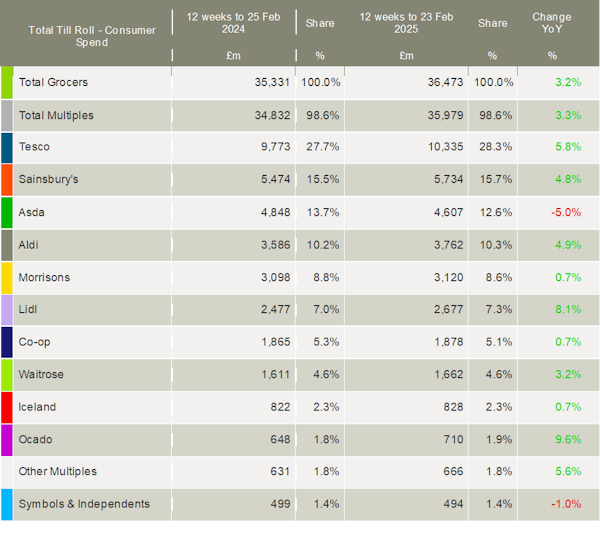Latest data from Kantar shows take-home sales at the UK’s leading grocers rose by 3.6% over the four weeks to 23 February. However, this is weaker than the 4.3% figure recorded the previous month, with promotions helping to hold grocery price inflation steady at 3.3%.
Items bought on offer now account for 27.6% of sales, a rise of 0.3 percentage points on last year. Premium own-label lines also continue to be popular, growing at 13.3% this month, as people seek cost-effective ways to treat themselves.
Over the 12 weeks to 23 February, Ocado was the fastest-growing retailer for the tenth consecutive month with spending increasing by 9.6% – holding its share of the market at 1.9%. M&S has also continued its growth trajectory with grocery sales climbing by 12.2% across its bricks & mortar stores.
Looking at the discounters, Aldi accelerated its growth by attracting 377,000 more shoppers through its doors. The retailer achieved a market share of 10.3% following a 4.9% rise in sales – its highest rate since January 2024. Lidl also saw its portion of the market rise by 0.3 percentage points to 7.3% after seeing sales increase by 8.1%.
As Tesco celebrates the 30th anniversary of its Clubcard loyalty scheme, the UK’s largest grocer now controls 28.3% of the market after its sales growth reached its highest rate since March 2024 at 5.8%. Second-placed Sainsbury’s also made gains, increasing its share of the market from 15.5% to 15.7% compared to this time last year.
Meanwhile, Morrisons’ share slipped to 8.6% after spending in its stores was unchanged compared to last year. And despite the recent launch of a major price-cutting campaign, Asda continued its poor run, with its sales sliding 5.0%.

Meanwhile, as the five-year anniversary of the first Covid-19 lockdown in the UK approaches, Kantar outlined how consumers’ grocery habits have evolved since then.
Sally Ball, the research group’s head of retail, said: “Back in 2020, we didn’t know just how big an impact the Covid-19 pandemic would have on our lives, but five years on we can get a picture of its lingering effects on consumers. We haven’t gone back to old patterns and shopping trips remain below pre-pandemic times. Households made one less visit to the supermarket in February 2025 than in 2020, while online shopping appears to have stuck, taking a 12.3% market share this month versus 8.6% in February 2020.
“One of the most interesting changes has been a move to simpler eating habits as we look for convenient shortcuts to make our lives easier. People are taking less time to prepare meals, and prep time in the evening, for example, has declined from almost 34 minutes in 2020 to 31 minutes in 2024.”
Kantar consumption data also shows that people are now using fewer different ingredients when making food, both at lunch and in the evening. Consumers are snacking less often too, dropping more than 330 million occasions in 2024 versus 2020.
Ball added: “Of course, it’s hard to untangle the cost of living crisis from any post-Covid analysis, and the other big headline of the past few years has been consumers’ hunt for value. You might think that people would shop around more to find the best deals but in fact, that’s not the case. Households visited just under five different grocers this month, the lowest level in February since 2021. The growth of supermarket loyalty schemes is partly behind this as shoppers use them to unlock exclusive discounts.”
NAM Implications:
- The key standout has to be the growing shares of Tesco, Sainsbury’s, Aldi and Lidl…
- …at the expense of Asda and Morrisons.
- Causing us to wonder if there is any way back for Asda and Morrisons?
- The other issue has to be the unprecedented impact of Lockdown on businesses everywhere…
- Resulting in the dilution of consumer belief in ‘everything’.
- Causing consumers to view with suspicion the size of the brand premium when private label ‘substitutes’ were found not to be as much of a compromise as anticipated.
- Begging the question: How much will brands have to spend to win back loyalty?



